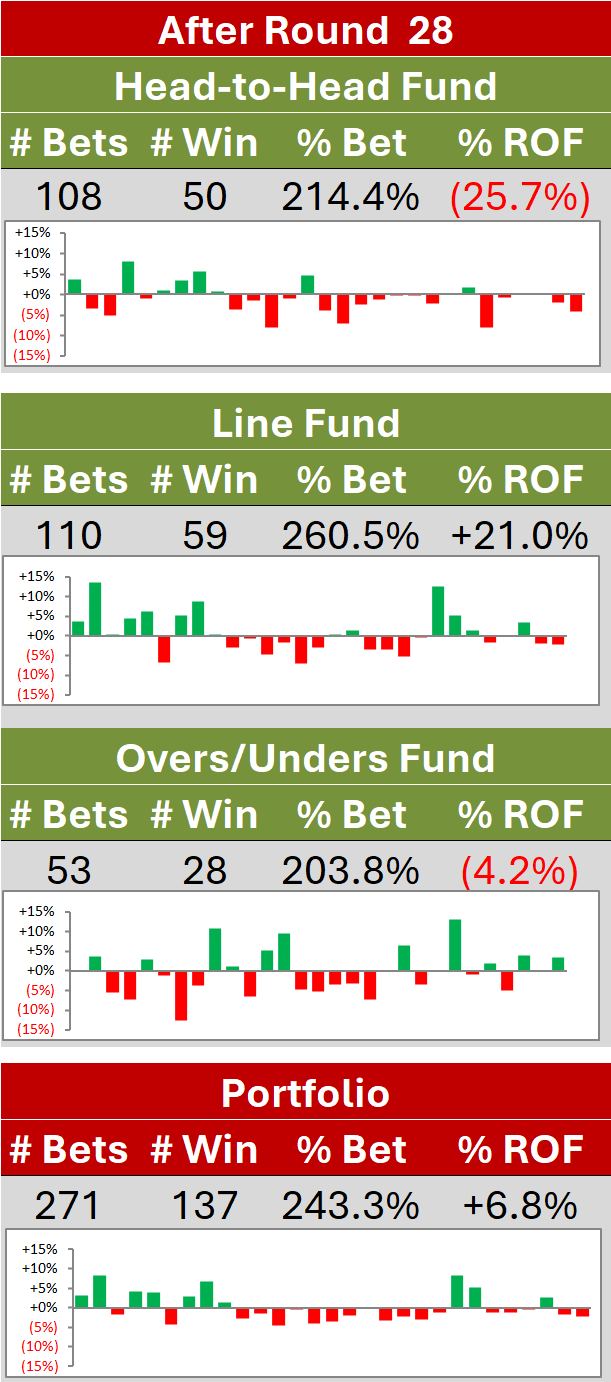TEAM v team related ChARTS ON THIS PAGE
Team v Team Winning Rates in Home-and-Away Games
Here we explore the all-time winning rates in the home-and-away season between every pair of teams. Each row records the rate achieved by a particular team against all possible opponents, with darker blue dots denoting lower winning rates and darker orange dots higher winning rates. The size of the dot denotes the number of times that the pair of teams have met.
There are a number of pairs where the winning rates are quite distant from 50% even though the teams have met a large number of times. For example, Carlton and Collingwood both have near 75% records against St Kilda despite having played them over 200 times. Essendon also has a 67% win rate against St Kilda, also from over 200 games.
No team has a 100% record against another team: closest are Collingwood, Carlton, and Sydney/Sth Melbourne, who are all at 93-96% against University after 14 games. Port Adelaide is next best with an 87.5% record against Gold Coast from 16 games.
We can get an idea of how teams' dominance of and by other teams has shifted across time by performing the same analysis after defining 6 football eras.
Looking solely at the most-recent era, which is defined as running from 2000 to 2024, we find a number of surprising skews:
Port Adelaide has won 88% of the time against Gold Coast (16 games)
Melbourne has won 83% of the time against Gold Coast (18 games)
Geelong has won 81% of the time against Richmond (31 games)
Adelaide has won 79% of the time against Gold Coast (19 games)
Port Adelaide has won 78% of the time against St Kilda (32 games)
Sydney has won 78% of the time against North Melbourne (34 games)
Team v Team Winning Rates In Finals
Here we look all-time but only at games that were classified as Finals
There are a number of teams with 100% records in Finals against other teams, including Adelaide against all of Fremantle (2 games), Geelong (2), GWS (1), North Melbourne (2), and Port Adelaide (1). If we set a minimum number of games at 5, we get only Carlton with its 5 from 5 record against the Saints.
Another impressive record is Melbourne’s 75% record against Collingwood across 22 games.
Here we also look all-time and only at Finals, but we now carve history up into 6 eras.
Looking solely at the most-recent era, which is defined as running from 2000 to 2024, we find a number of skews, although game counts are low. These include
Hawthorn with an 80% record across 5 games playing Sydney
Geelong with a 71% record across 7 games playing Collingwood
Collingwood and Hawthorn with 67% records across 6 games playing West Coast and Geelong, respectively
TEAM v TEAM AVERAGE MARGINS BY ERA
Here we look at the average victory margin in clashes between pairs of teams, with a view to determining which pairs tend to have more closely fought contests. The dots are now coloured on the basis of the average victory margin.
One obvious feature is that margins generally were smaller in earlier eras, which is also when average scores tended to be lower (see chart below). Nonetheless, some pairs have produced relatively low average margins even in more recent eras.
Looking solely at the 2000-2024 era and restricting our attention to pairs that have met at least 20 times, we see that
Collingwood v Sydney games have had the smallest average margin (20.7 points in 35 games)
Adelaide v Collingwood games have had the next-smallest average margin (22.3 points in 37 games)
Sydney v Essendon games have had the third-smallest average margin (24.4 points in 36 games)
Geelong v West Coast games have had the highest average margin (44.6 points in 34 games)
Geelong v Essendon games have had the second-highest (43.1 points in 31 games)
Carlton v West Coast games have had the third-highest (42.5 points in 29 games)
TEAM v TEAM PROPORTION OF CLOSE GAMES BY ERA
Sometimes, an average can be a deceptive measure of centrality, in particular when the underlying data is what's called "bimodal" - that is, is clumped around two distinct values, one small and one large - or when it has a "long tail" because of relatively few but very large values. Given that, if we're interested in which pairs of teams have most commonly produced close contests we might want to look solely at the proportion of times they've finished separated by less than 1 goal.
Even though scores tended to be lower in the earlier eras, we see that many pairings in the modern era have produced relatively high proportions of narrow victory margins.
In particular, for pairs that have played 20 times or more in the 2000-2024 era:
Adelaide v Collingwood games have been "close" 35% of the time (37 games)
Essendon v Sydney games have been "close" 28% of the time (36 games)
Geelong v Hawthorn games have been "close" 27% of the time (45 games)
Modern pairings that have struggled to produce close games in the 2000-2024 era (minimum 20 games) have been:
Fremantle v Hawthorn (0 close games from 35)
Adelaide v West Coast (only 1 close game from 41)
Brisbane Lions v Western Bulldogs (only 2 close games from 40)
TEAM v TEAM PROPORTION OF BLOWOUTS BY ERA
In the same way that the average can mask the prevalence of close games, it can also obscure the proportion of blowouts, which here we'll define as victory margins of 5 goals or more.
Blowouts, quite clearly, were far less frequent in the earlier eras, though there are pairings in the modern era that have produced relative few.
In particular, for pairs that have played 20 times or more in the 2000-2024 era:
Collingwood and Sydney have produced only 7 in 35 games
Adelaide and Collingwood have produced only 10 in 37 games
Collingwood and Geelong have produced only 12 in 31 games
Blowouts have been far more frequent in the 2000-2024 era for the following oft-meeting (minimum 20 games) pairs:
Essendon and Geelong (22 of 31)
Fremantle and Melbourne (25 from 37)
St Kilda and Essendon (21 from 32)
Team v Team Own and Total Scores by Era
We can get a sense for the offensive and defensive abilities of teams from different eras by analysing their average scores for and against different opponents, which we do in the chart below.
Immediately evident is the lower average team scores in earlier eras, and the spike in the 1980 to 1999 era.
In the 2000-2024 era, for pairs that have played 20 times or more:
Geelong has averaged 109 points per game against Essendon (31 games)
North Melbourne has averaged 107 points per game against Carlton (31 games)
Geelong has averaged 107 points per game against West Coast (34 games)
Also:
West Coast has averaged 71 points per game against Geelong (34 games)
West Coast has averaged 74 points per game against Sydney (36 games)
St Kilda has averaged 74 points per game against Sydney (39 games)
We can get a sense of the typical style of play - whether defence or offence tends to be more emphasised - by looking at the average aggregate scores produced when two teams meet. This we do in the chart below.
The tendency to lower scoring in the earliest eras of football is revealed perhaps most starkly of all in this chart, as is the spike in the 1980-1999 era.
In the 2000-2024 era, for pairs that have played 20 times or more:
Carlton v Brisbane Lions games have averaged 198 points per game (37 games)
Carlton v North Melbourne games have averaged 198 points per game (31 games)
Western Bulldogs v Essendon games have averaged 197 points per game (34 games)
Fremantle v St Kilda games have averaged 162 points per game (36 games)
Collingwood v Sydney games have averaged 162 points per game (35 games)
St Kilda v Port Adelaide games have averaged 163 points per game (33 games)


